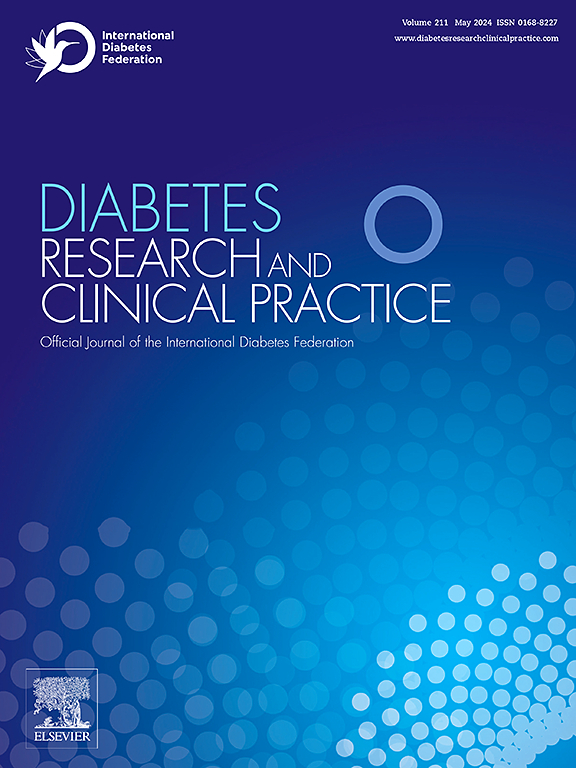Insulin resistance mediates the association between adiposity markers and incident chronic kidney disease: Findings from the UK Biobank prospective cohort study
IF 6.1
3区 医学
Q1 ENDOCRINOLOGY & METABOLISM
引用次数: 0
Abstract
Background
Limited research exists on fat distribution patterns and chronic kidney disease (CKD)/ end-stage kidney disease (ESKD) risks.
Methods
This UK Biobank study analyzed 398,307 adults without baseline CKD. Adiposity markers and insulin resistance (IR) indices (TyG index, TG/HDL-C ratio) were assessed. Hazard ratios (HR) and 95% CIs from Cox regression models evaluated adiposity markers and CKD/ESKD risks, with mediation analysis on IR.
Results
Over 13.62 years, 17,583 (3.37 per 1000 person-years) CKD and 1,509 (0.29 per 1000 person-years) ESKD cases occurred. After adjusting for BMI, high waist circumference and waist-to-hip ratio (WHR) were associated with a 23.0 % (HR: 1.23, 95 % CI: 1.19–1.27) and 17.0 % (HR: 1.17, 95 % CI: 1.12–1.22) increased risk of CKD and a 37.0 % (HR: 1.37, 95 % CI: 1.22–1.54) and 39.0 % (HR: 1.39, 95 % CI: 1.29–1.49) increased risk of ESKD, respectively. In the mediation analysis, BMI, waist circumference, and WHR accounted for 12 %, 44.4 %, and 23.8 % of the association between the TyG index and CKD, and 7.4 %, 26.7 %, and 13.9 % of the association between the TG/HDL-C ratio and CKD.
Conclusion
Elevated WHR was linked to increased risks of CKD and ESKD. The mediating effect of IR indexes between WHR and CKD was more significant than BMI.
胰岛素抵抗介导肥胖标记物与慢性肾脏疾病之间的关联:来自英国生物银行前瞻性队列研究的发现
背景:关于脂肪分布模式与慢性肾脏疾病(CKD)/终末期肾脏疾病(ESKD)风险的研究有限。方法:这项英国生物银行研究分析了398,307名基线无CKD的成年人。评估肥胖指标和胰岛素抵抗(IR)指标(TyG指数、TG/HDL-C比值)。Cox回归模型的风险比(HR)和95% ci评估了肥胖标志物和CKD/ESKD风险,并对IR进行了中介分析。结果:在13.62 岁以上,发生了17583例(3.37 / 1000人年)CKD和1509例(0.29 / 1000人年)ESKD。调整BMI后,高腰围和腰臀比(WHR)分别与CKD风险增加23.0 % (HR: 1.23, 95 % CI: 1.19-1.27)和17.0 % (HR: 1.17, 95 % CI: 1.12-1.22)和ESKD风险增加37.0 % (HR: 1.37, 95 % CI: 1.22-1.54)和39.0 % (HR: 1.39, 95 % CI: 1.29-1.49)相关。在中介分析中,BMI、腰围和WHR在TyG指数与CKD的关联中分别占12 %、44.4 %和23.8 %,在TG/HDL-C比值与CKD的关联中分别占7.4 %、26.7 %和13.9 %。结论:WHR升高与CKD和ESKD风险增加有关。IR指标在WHR与CKD之间的中介作用比BMI更显著。
本文章由计算机程序翻译,如有差异,请以英文原文为准。
求助全文
约1分钟内获得全文
求助全文
来源期刊

Diabetes research and clinical practice
医学-内分泌学与代谢
CiteScore
10.30
自引率
3.90%
发文量
862
审稿时长
32 days
期刊介绍:
Diabetes Research and Clinical Practice is an international journal for health-care providers and clinically oriented researchers that publishes high-quality original research articles and expert reviews in diabetes and related areas. The role of the journal is to provide a venue for dissemination of knowledge and discussion of topics related to diabetes clinical research and patient care. Topics of focus include translational science, genetics, immunology, nutrition, psychosocial research, epidemiology, prevention, socio-economic research, complications, new treatments, technologies and therapy.
 求助内容:
求助内容: 应助结果提醒方式:
应助结果提醒方式:


